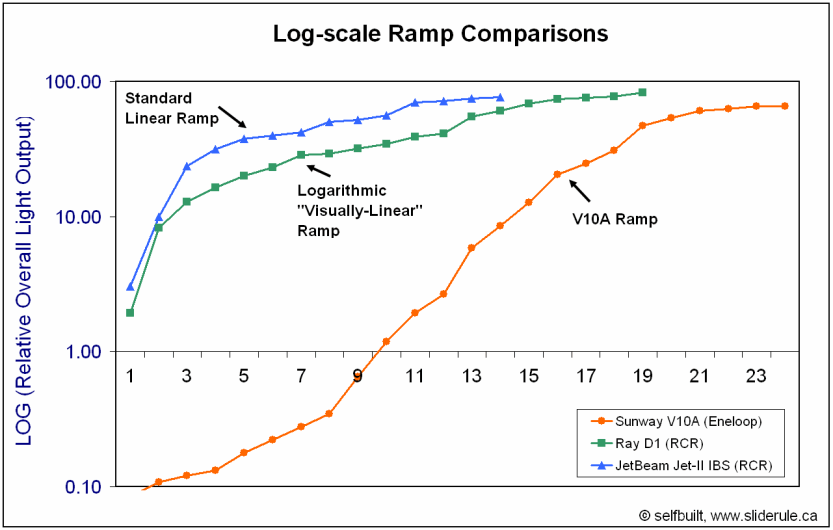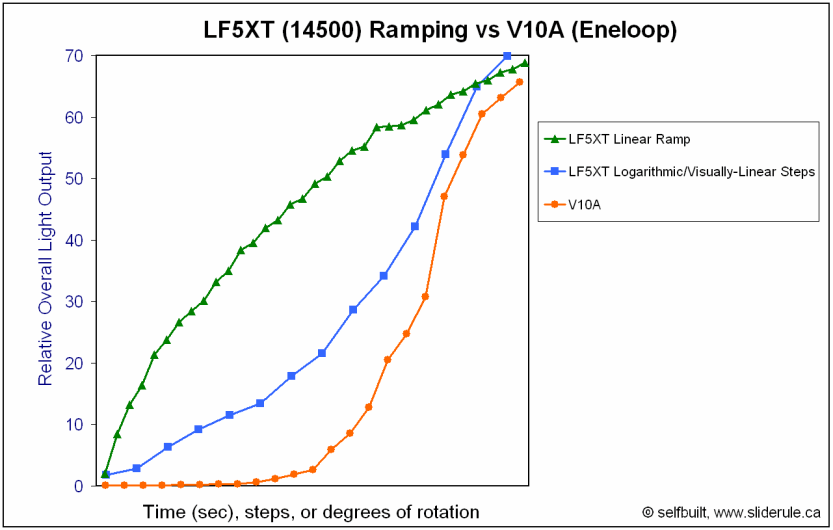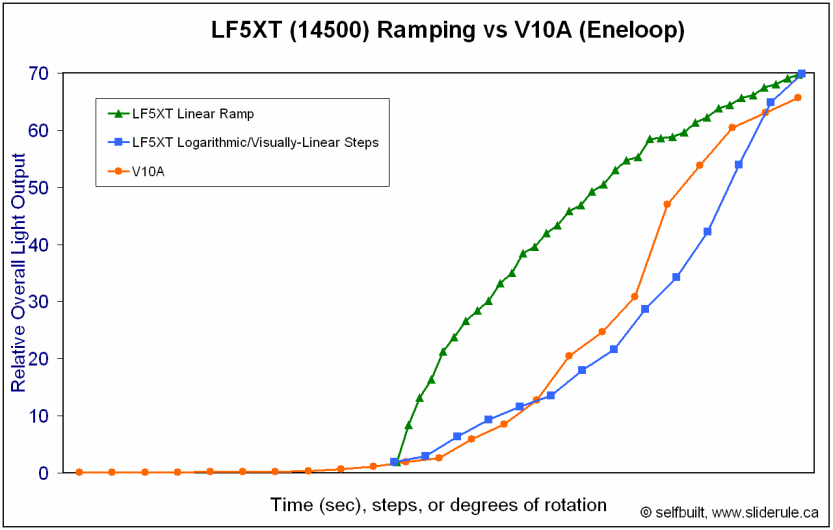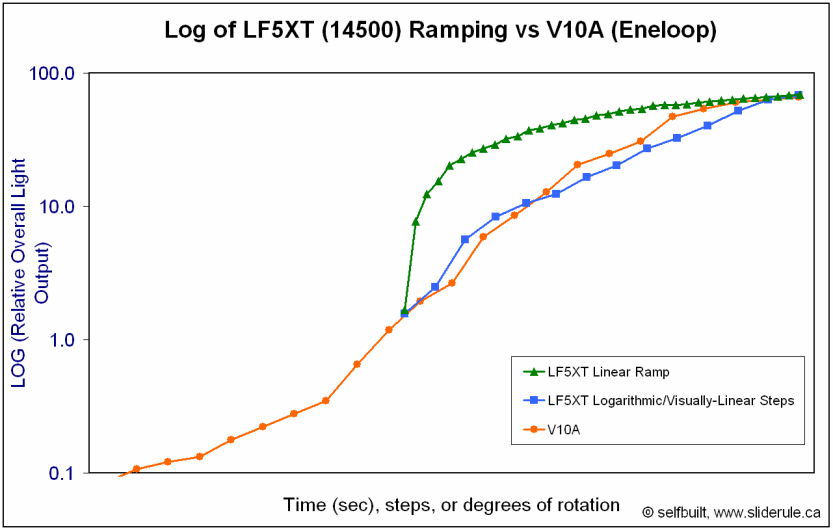Warning: pic heavy, as usual. 
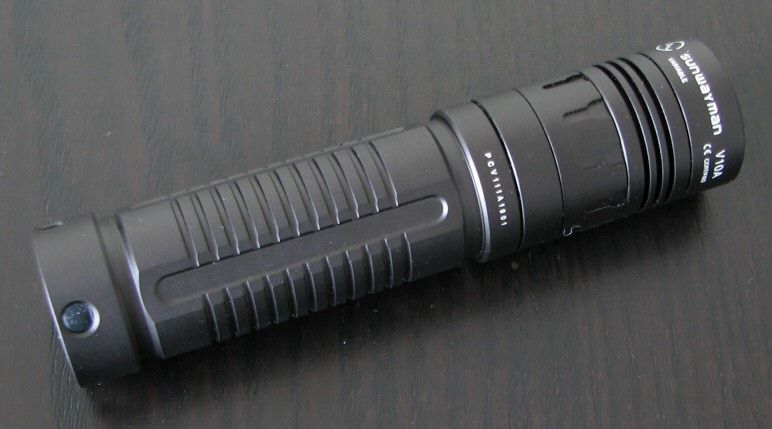
Specifications:
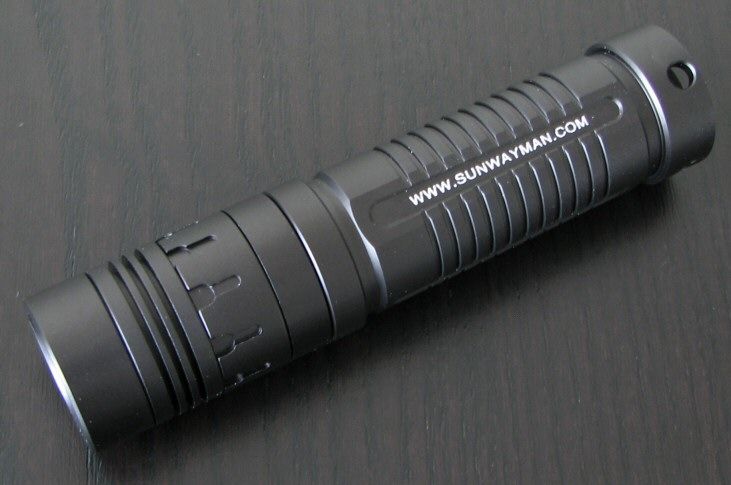
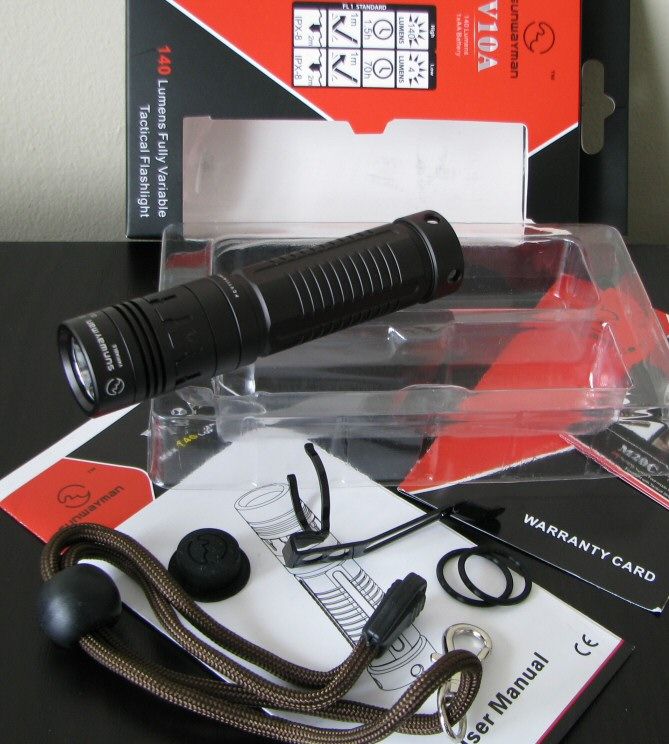
Packaging hasn't changed much. The light comes in a typical cardboard box with the usual extras - manual, warranty card, promotional insert, good quality wrist strap, pocket clip, extra o-rings and boot cover.
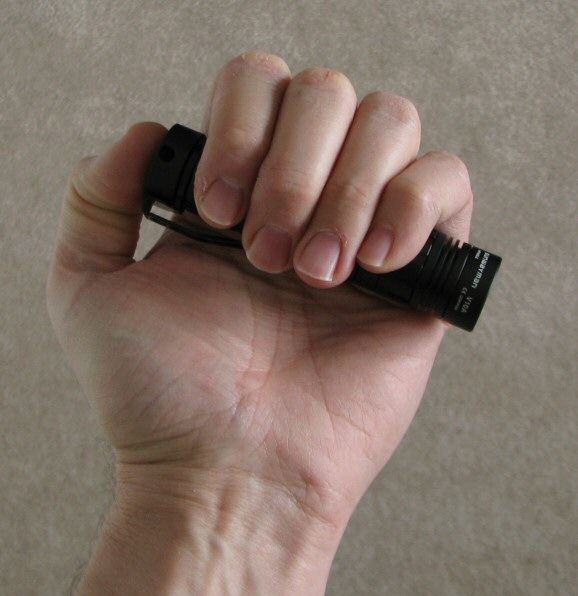

From left to right: Duracell AA, Sunwayman V10A, Xeno E03, Fenix LD10-R4, 4Sevens Quark AA, Crelant 7G1, Zebralight SC51, Sunwayman L10A
V10A:: Weight: 58.1g (no battery), Length 100.6mm x Width 23.1mm (bezel)
The overall dimensions are pretty standard for a typical 1xAA light, if a bit on the tall side.
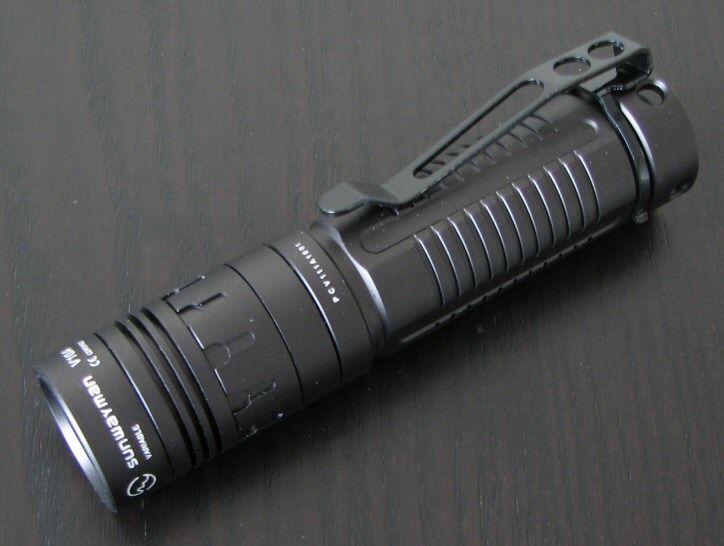
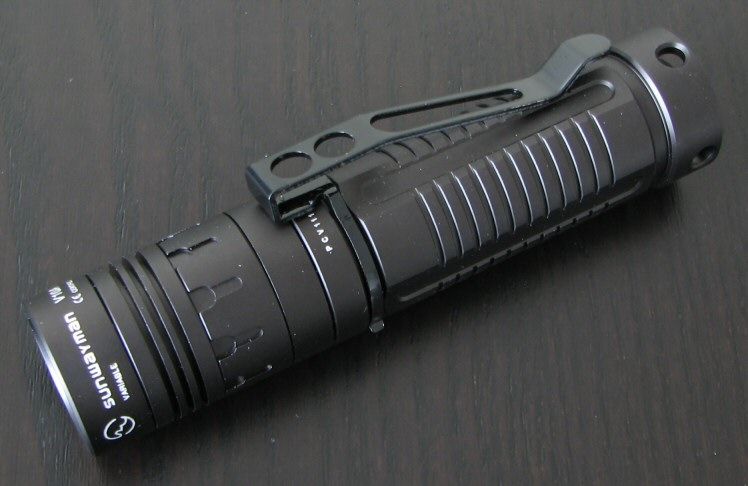

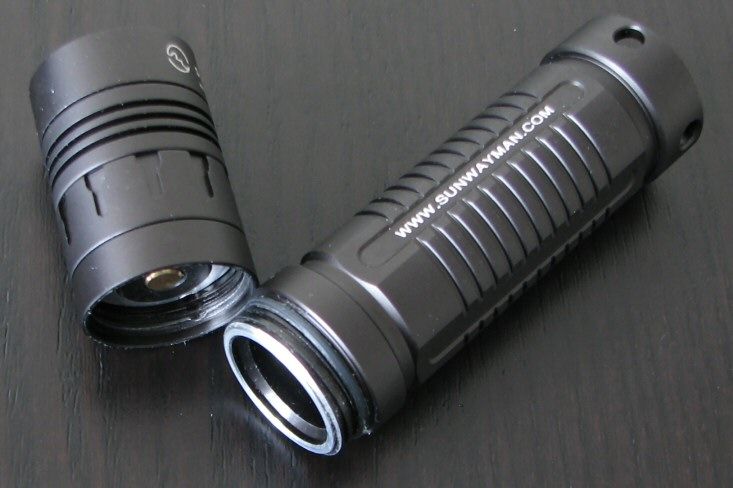
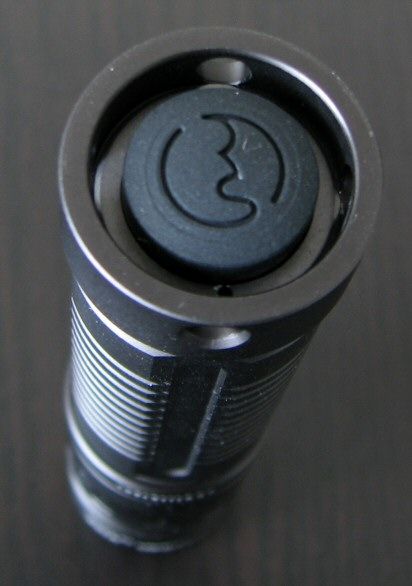
Build of the V10A remains excellent overall.
Although virtually indistinguishable from the recent M-series lights, the control ring is now smooth over the range (i.e. no detents, as no defined levels). Max range of the ring is unchanged at around 1/3 the total circumference of the light.
The rest of build hasn't changed. The light can still tailstand (with forward clicky switch). Square-cut screw threads remain anodized for lockout (but still only have a limited number of turns).
The included pocket clip is serviceable, but these sorts of clip-on clips will never be as study or stable as ones that goes around the body tube.
Fit and finish is perfect on my sample, in the classic natural color common to Sunwayman lights. Lettering is bright white and clear. As before, there is no real knurling, so gripability is toward the low side (unless you have the clip attached).
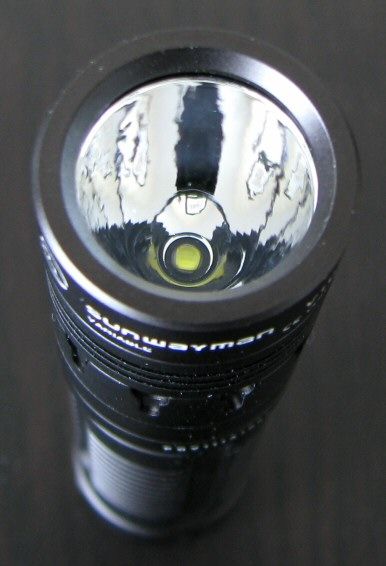
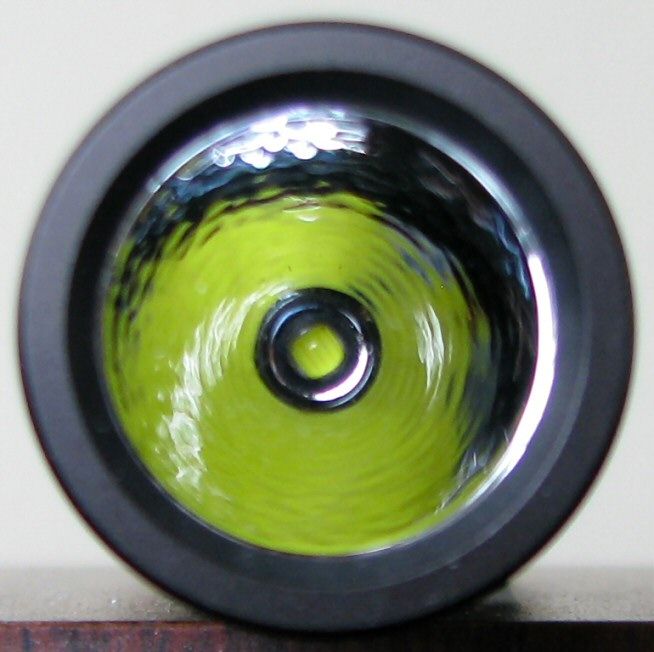
Like the more recent M-series lights, the V10A comes with the Cree XP-G R5 Cool White. The reflector is what I would consider a light texturing/orange peel (LOP).
Which brings us to the requisite white wall hunting . All lights are on Hi on Sanyo Eneloop, about ~0.75 meter from a white wall (with the camera ~1.25 meters back from the wall). Automatic white balance on the camera, to minimize tint differences.
. All lights are on Hi on Sanyo Eneloop, about ~0.75 meter from a white wall (with the camera ~1.25 meters back from the wall). Automatic white balance on the camera, to minimize tint differences.
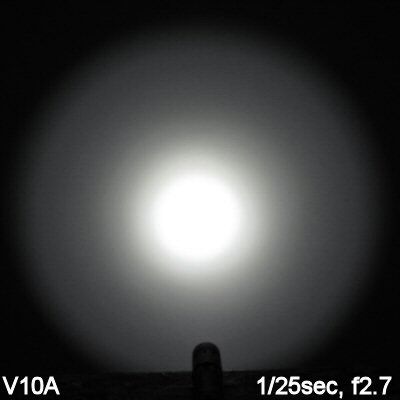
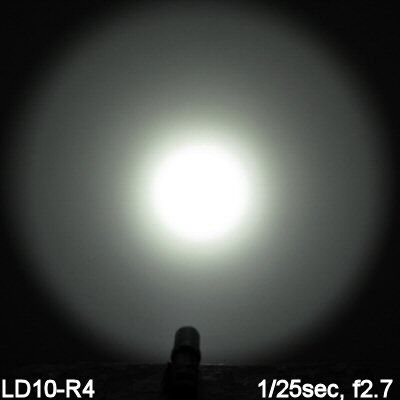
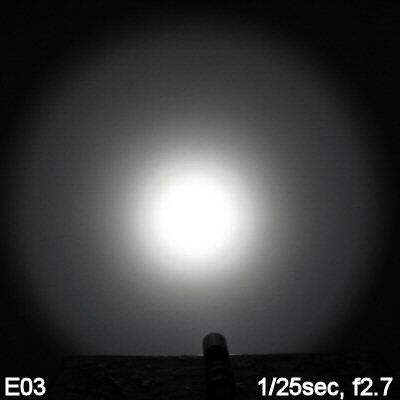
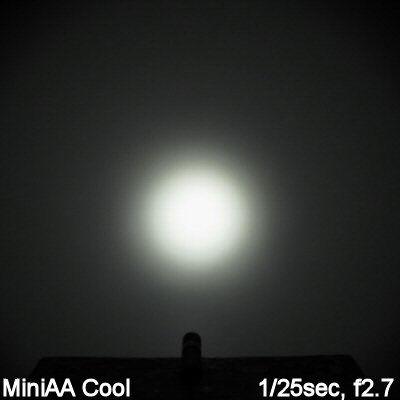
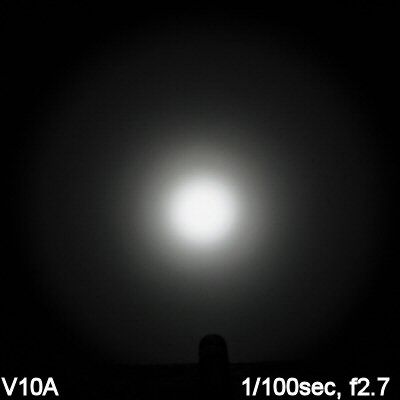
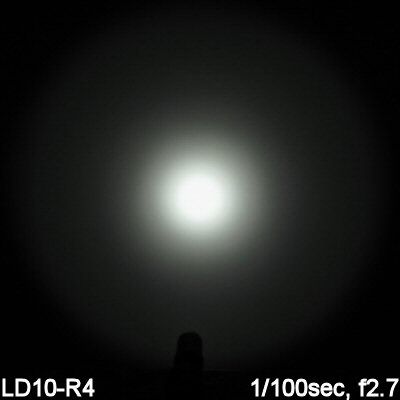
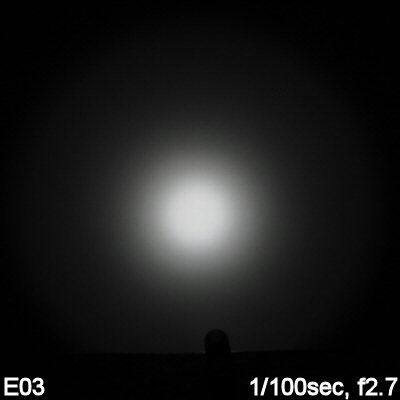
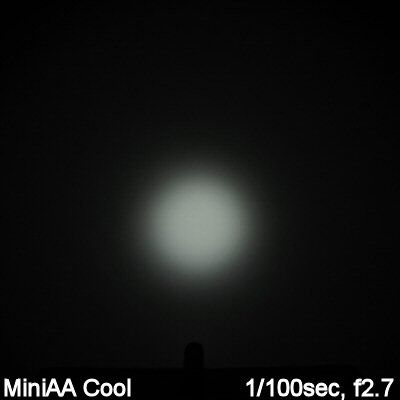
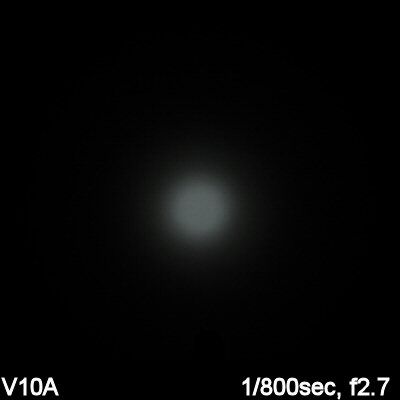
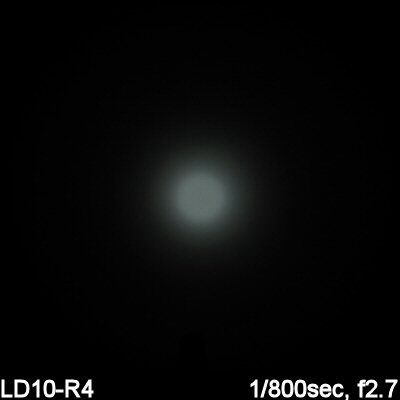
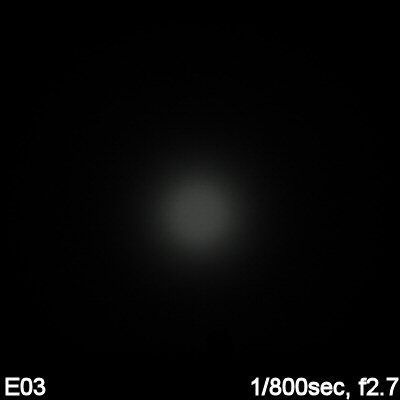
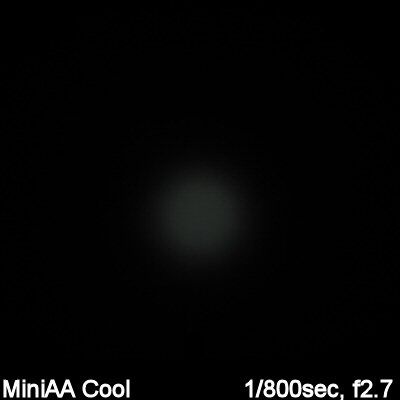
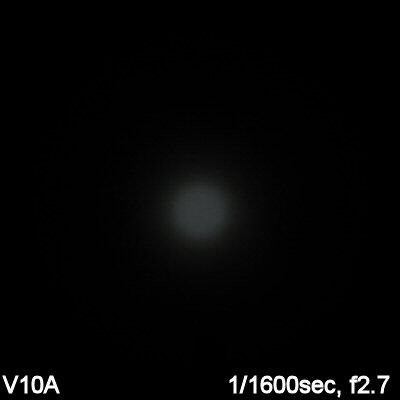
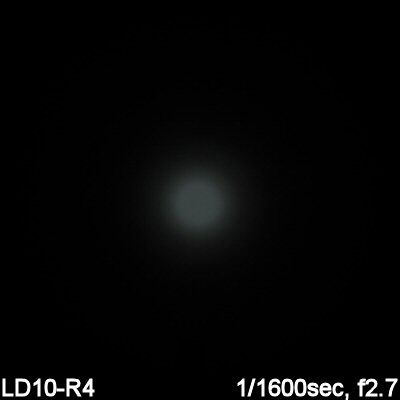
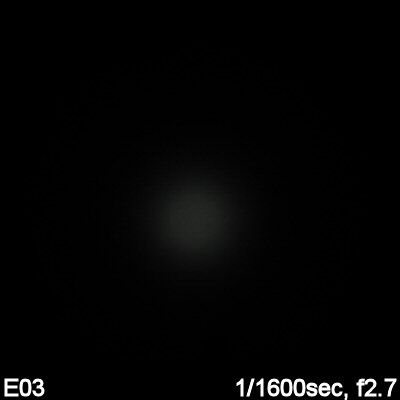
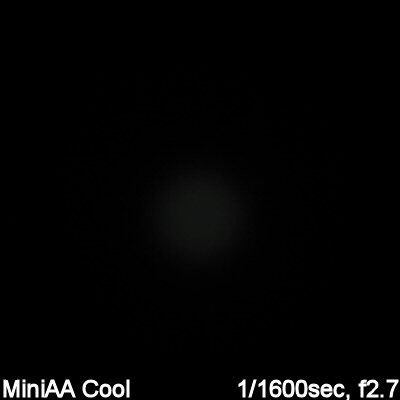
As you can see, the beam profile of the V10A is in keeping with its class. Up close, I notice some faint rings in the beam, but these are not so great as to be disturbing (MOP may have helped here).
Scroll down to my Summary Tables and runtimes for more specifics on output.
User Interface
Like with the M-series lights, you turn the light on by the tailcap switch. Half-press the tailcap for momentary-on, click for locked-on
Mode switching is controlled by the magnetic control ring. The V10A features a continuously-variable interface – you control the output level by twisting the ring. You can select your desired mode while the light is off.
And that's it - no blinking modes, no standby modes.
Ramping Pattern
EDIT: this section has been updated and revised from my initial post.
The big question is whether the output selection of the V10A is "visually linear". Generally, here on the forums, that has been taken to mean a logarithmic ramp as opposed to an actual linear ramp of outputs. The reason for this is that we perceive brightness in a non-linear way (actually, not just brightness - most of our sensory perceptions are non-linear). This is why twice the lumens doesn't appear twice as bright to us - lumens are an objective (linear) measure of output, and our subjective perceptions are not linear.
A logarithmic adjustment has long been used to adjust for our relative visual perceptions (e.g. the stops of camera are logarithmic). And like most here, up until now I have found that all continuously-variable lights with a logarithmic correction of output generally look "visually-linear". And then the V10 came along.
To start, here is what the V10 looks like in my lightbox. To measure this, I slowly turned the ring at as close to a constant rate as I could manage, over ~25 secs or so. My lightbox collected output readings every second, and I then plotted the relative lightbox output against the estimated degree shift of the ring (i.e. with 360 degrees being a complete turn). Note the ring only turns about 1/3 the circumference of the light, or about 120 degrees.
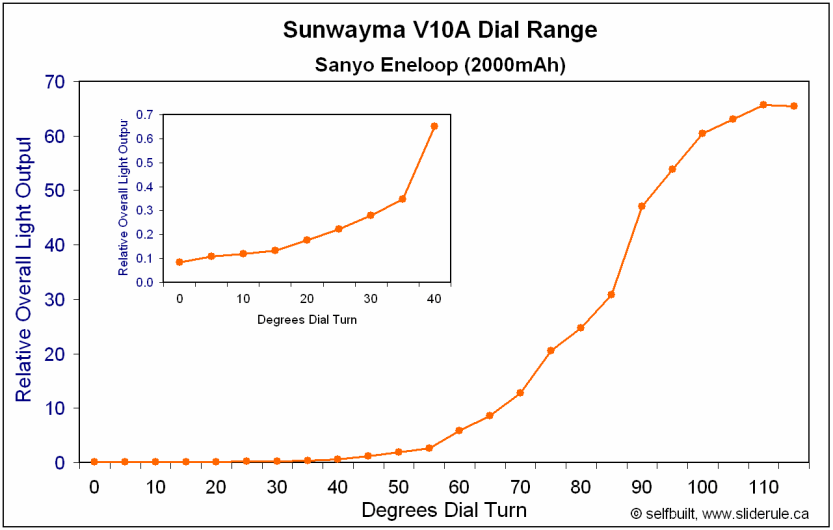
I have blown-up the first third of the ramp in the inset graph, to show you that output does indeed increase over the whole ring (albeit seemingly slowly at first). Now, you can certainly argue that the output trace looks like it could be logarithmic. Indeed, if you plot it on a log scale, you get something approximating a straight line. However, the V10A does NOT subjectively appear to me to be visually-linear when handling (e.g. it does indeed spend a lot of time at the very low outputs over the first third of the ring).
Upon reviewing the scientific literature, I see that relative power relationships have superseded simple logarithmic corrections for linearizing our sensory perceptions. For perceived brightness, the currently accepted linearization method is actually a cube root of output. For a full discussion of this - including detailed graphs and primary literature references - please see my post #3 below.
When plotting with a cube root transformation of my lightbox's output scale, you get the following graph:
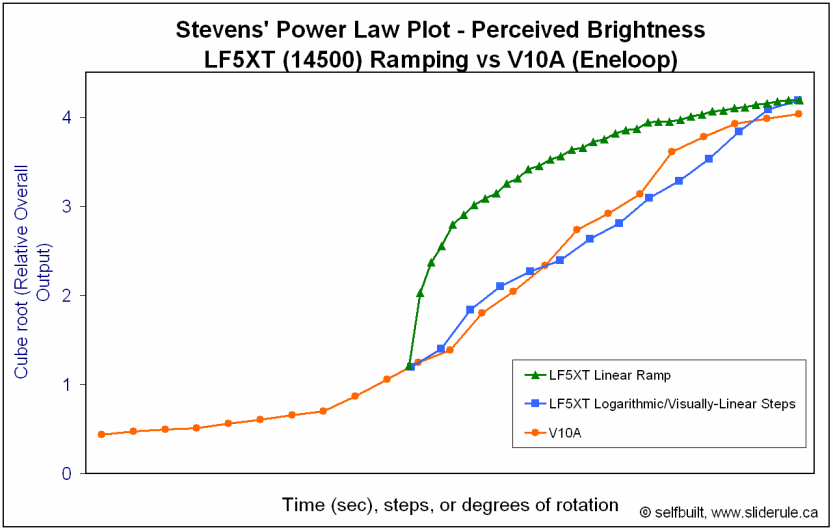
This graph MUCH better matches what I see by eye for the V10A, compared to a logarithmic plot. :thumbsup: I have added the LiteFlux LF5XT to the graph, as it does both a linear ramp and a logarithmic step pattern. Max output on the LF5XT on 14500 is also pretty close to the V10A on Eneloop, which facilitates comparisons. The linear and logarithmic ramps of the LF5XT also pretty closely match my relative perceptions.
The point to the above is to show that the V10A goes to much lower outputs than any other linear or logarithmic continuously-variable light I've seen before. It also betters matches what I subjectively see across the whole range of outputs on these lights. So for now on, I will also include this type of plot (along with standard linear plots) for all the continuously-variable lights I review.
All that aside, I actually consider this dynamic range control of the V10A to be superior to a purely "visually-linear" ramp across the whole range. The logarithmic correction allows you to exquisitely fine-tune your low output selection. :thumbsup: And once you get into brighter outputs, the proportional increase seems quite linear.
Current Draw
You would hope that this wide range of low modes translates into a range of super-long runtimes. Unfortunately, the circuit overhead for this level of control is considerable, and Sunwayman estimates max runtime to be only 4 days.
I have measured the battery current draw at the lowest output as 50mA on 1xNiMH, which for a 2000mAh Eneloop would translate into 40 hours runtime. On 1x14500 (750mAh), I measure 13mA, which would translate into just under 58 hours. So, basically 1.5-2.5 days is all you can reasonably expect for most batteries :shrug:
PWM
I presume the light uses PWM for the variable outputs, but I was unable to detect the frequency with my setup (which means it must be in the high kHz range). It is certainly not detectable visually. :thumbsup:
At the highest output levels (i.e. over the last quarter turn of the ring), I was able to detect a weak signal in the near ~900Hz range on Eneloop and low 3kHz range on 14500. This seems to be some sort of circuit artifact – it definitely isn't the PWM freq, as you could easily spot those levels with an oscillating fan.
Testing Method:
All my output numbers are relative for my home-made light box setup, a la Quickbeam's flashlightreviews.com method. You can directly compare all my relative output values from different reviews - i.e. an output value of "10" in one graph is the same as "10" in another. All runtimes are done under a cooling fan, except for any extended run Lo/Min modes (i.e. >12 hours) which are done without cooling.
I have recently devised a method for converting my lightbox relative output values (ROV) to estimated Lumens. See my How to convert Selfbuilt's Lighbox values to Lumens thread for more info.
Throw/Output Summary Chart:
Effective November 2010, I have revised my summary tables to match with the current ANSI FL-1 standard for flashlight testing. Please see http://www.sliderule.ca/FL1.htm for a description of the terms used in these tables.
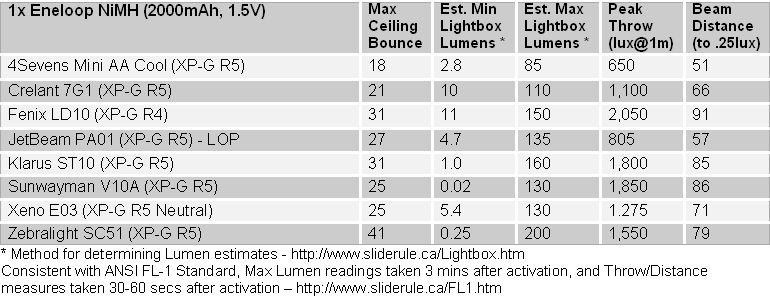
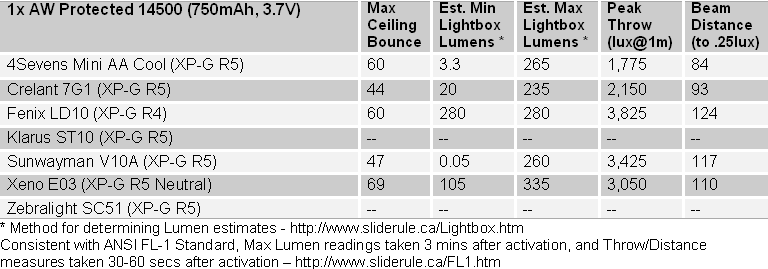
As you can see, the V10A's max output and throw are very consistent for this class of emitter and light, on all batteries (i.e. it is much brighter on 14500). The lowest output mode is incredibly dim - I can barely measure it in my lightbox. Simply put, you can stare into the illuminated emitter quite comfortably at the lowest levels. :thumbsup:
Output/Runtime Comparison:
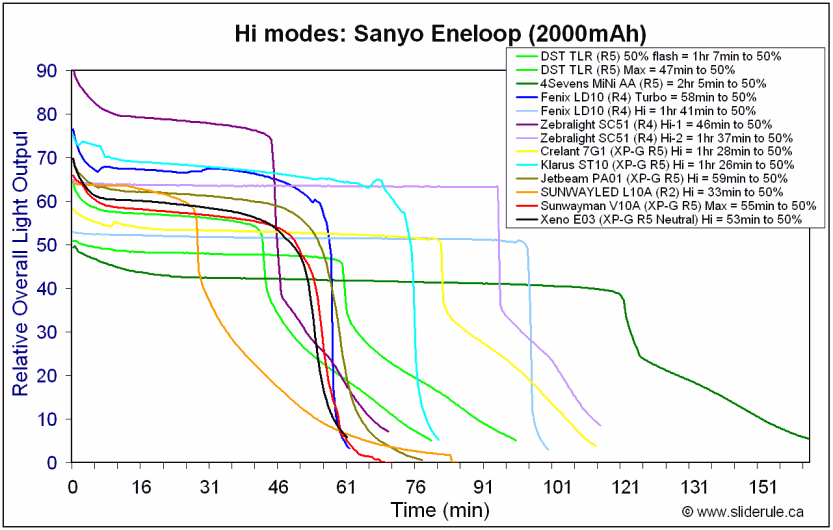
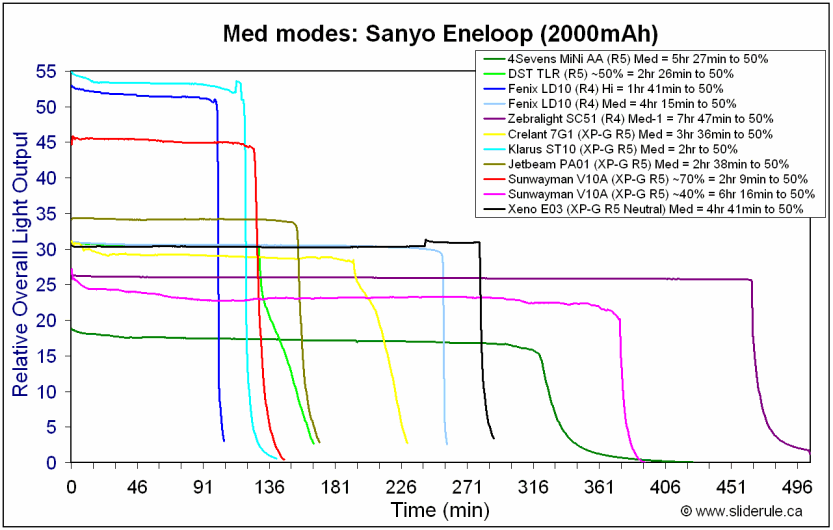
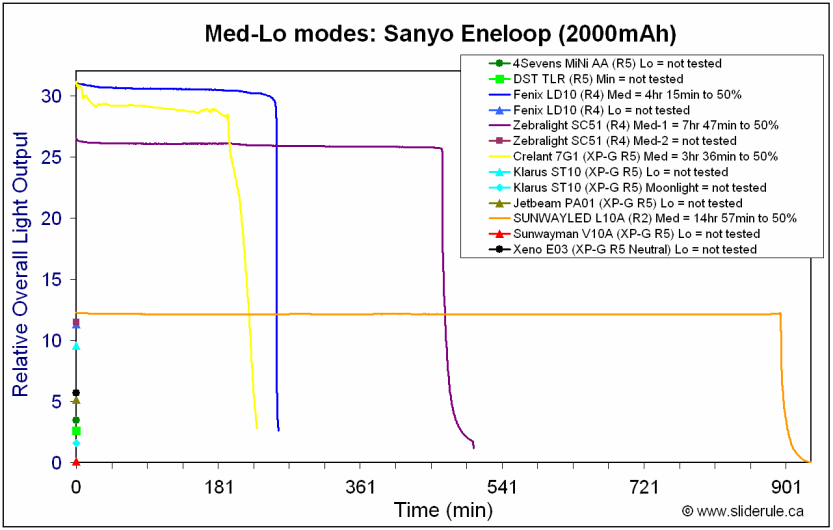

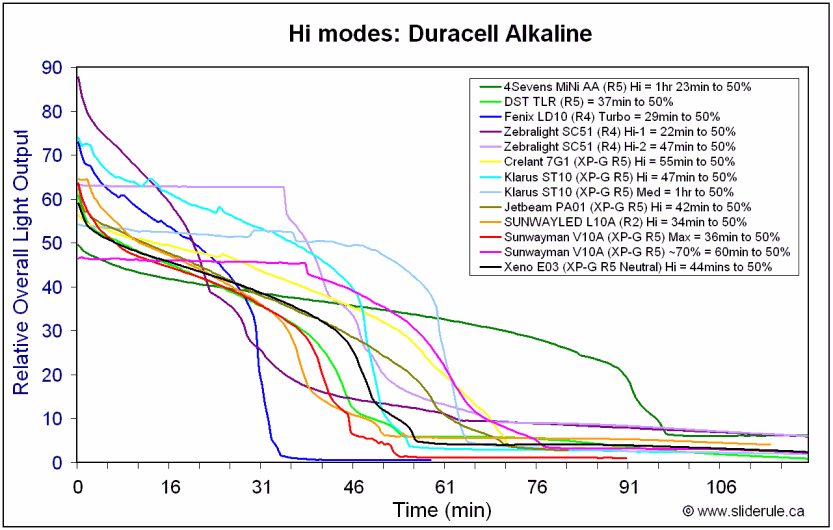
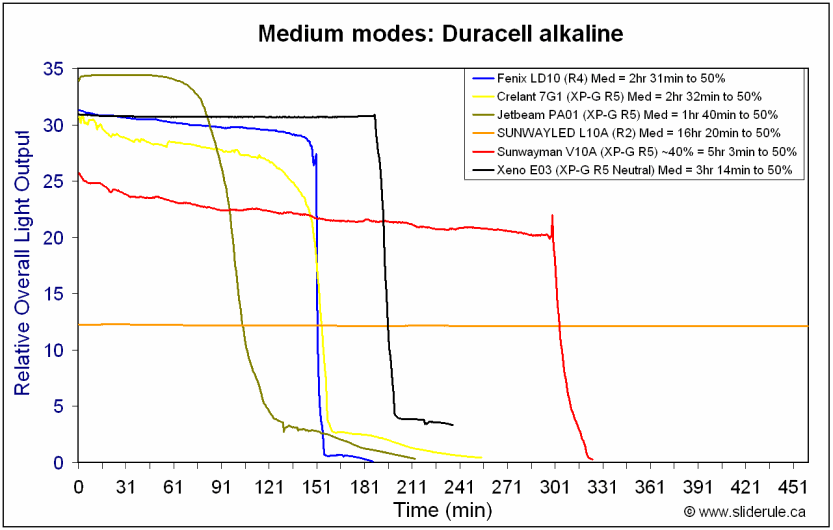

Note for the runs below that I set the control ring based on Eneloop output levels, so "~70%" and "~40%" don't really apply to the 14500 runs. Rest assured, the light can go quite low on 14500 – almost as low as on standard batteries.
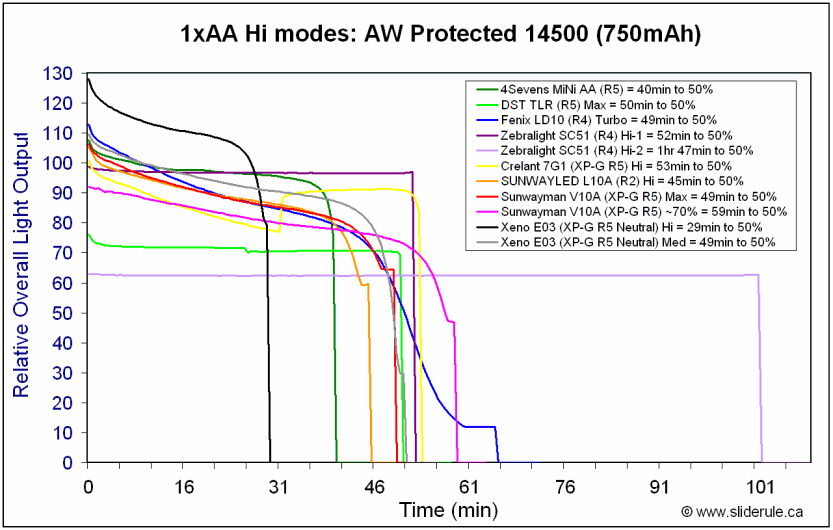
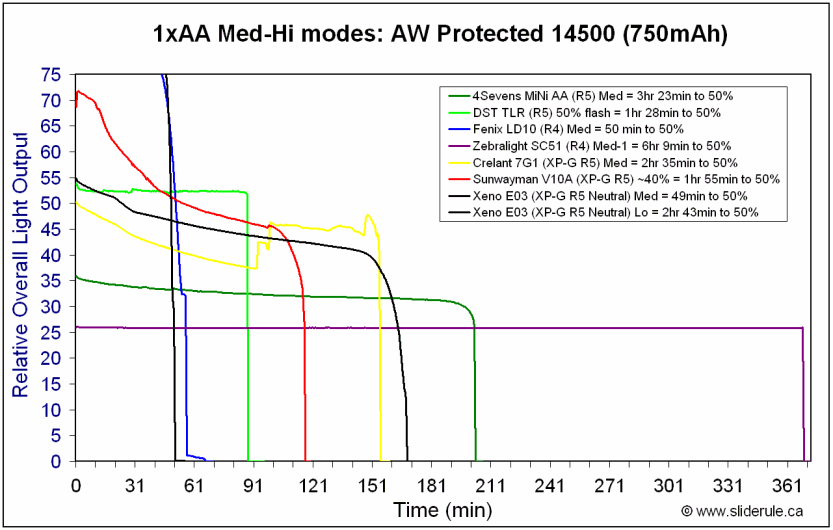
Overall efficiency seems reasonably good across the range of levels tested - especially considering the continuously-variable interface and (presumed high frequency) PWM-control.
Of course, a current-controlled light with a limited number of defined (and optimized) output levels would be expected to outperform at comparable outputs. But the V10A seems at least consistent with typical defined-level PWM-based XP-G R5 lights.
Potential Issues
Some of the first batch of lights had an issue with flickering at lower output levels. These were recalled, and all currently shipping lights should be flicker-free.
Clip is basic, and may not adequately hold the light if sudden force is applied. Recommend you use a holster or the included wrist lanyard to secure the light.
Light body is fairly smooth (i.e. low in grip).
Relatively few screw threads hold the head onto the body.
Estimated runtime is not as great as you might expect on the ultra-low levels.
Preliminary Observations
I generally like the overall design and build of most of the Sunwayman lights, and the V10A is no exception. It shares most of the same design elements as the M10A and M10R, so it will seem very familiar to CPF users. The one exception is the control ring, which no longer has defined level detents, but is smooth across a continuously-variable range of outputs.
IMO, the dynamic range of the continuously-variable control ring is excellent on the V10A. While not consistently "visually-linear" in the classic sense, it is quite cleverly designed to allow you to access a wide range of low outputs, and then quickly access a roughly visually-linear set of high outputs. This is the first time I've seen this particular pattern, and it makes a lot of intuitive sense to me as I turn the ring (see the output ramp graph earlier in this review).
The total traverse of the control ring is consistent with the earlier defined-level M-series lights, at around one third the total circumference of the light. Given the continuously-variable interface here, I would have preferred a bit of a wider range, but that's a minor point.
I like the lack of detectable PWM with the V10A – rare on a continuously-variable light. :thumbsup: For this type of light, output/runtime efficiency seems quite good across the range of outputs directly measured. However, the overhead on the circuit seems fairly high, with an estimated lowest mode runtime of only 1.5-2.5 days, depending on battery source. :shrug:
I also really like the ability to use both standard batteries and 14500, with each battery type maintaining appropriate and reasonable output range control. Sunwayman has definitely gotten that right with the circuit - it provides a nice range of options for the end user. :twothumbs
To get a better feel for how the interface works in practice, I will be carrying this light around as my main EDC for the next little while. I will keep you posted on my experiences!
----
V10A supplied by Sunwayman for review.

Specifications:
- LED: CREE R5 LED (Cool White)
- Digital Sensor Magnetic Control system, Infinite Variable Output Switch - slightly twist the Rotator Ring from left to right for Min to Max output.
- Max: 140 Lumens
- Min: 1 Lumen
- Constant current circuit, constant output
- Uses one single AA battery (Alkaline, Lithium, or Ni-MH) (Batteries not included)
- High quality reflector maintains great throw distance and spread, as well as perfect beam pattern
- Aerospace-grade aluminum alloy
- Military Specification Type III- hard anodized body
- Waterproof, in accordance with IPX-8 standard
- Ultra-clear tough glass lens resists scratches and impacts
- Tactical forward click switch for momentary on
- Tail stand capable- can be used as a candle
- Estimated MSRP ~$85


Packaging hasn't changed much. The light comes in a typical cardboard box with the usual extras - manual, warranty card, promotional insert, good quality wrist strap, pocket clip, extra o-rings and boot cover.


From left to right: Duracell AA, Sunwayman V10A, Xeno E03, Fenix LD10-R4, 4Sevens Quark AA, Crelant 7G1, Zebralight SC51, Sunwayman L10A
V10A:: Weight: 58.1g (no battery), Length 100.6mm x Width 23.1mm (bezel)
The overall dimensions are pretty standard for a typical 1xAA light, if a bit on the tall side.





Build of the V10A remains excellent overall.
Although virtually indistinguishable from the recent M-series lights, the control ring is now smooth over the range (i.e. no detents, as no defined levels). Max range of the ring is unchanged at around 1/3 the total circumference of the light.
The rest of build hasn't changed. The light can still tailstand (with forward clicky switch). Square-cut screw threads remain anodized for lockout (but still only have a limited number of turns).
The included pocket clip is serviceable, but these sorts of clip-on clips will never be as study or stable as ones that goes around the body tube.
Fit and finish is perfect on my sample, in the classic natural color common to Sunwayman lights. Lettering is bright white and clear. As before, there is no real knurling, so gripability is toward the low side (unless you have the clip attached).


Like the more recent M-series lights, the V10A comes with the Cree XP-G R5 Cool White. The reflector is what I would consider a light texturing/orange peel (LOP).
Which brings us to the requisite white wall hunting
















As you can see, the beam profile of the V10A is in keeping with its class. Up close, I notice some faint rings in the beam, but these are not so great as to be disturbing (MOP may have helped here).
Scroll down to my Summary Tables and runtimes for more specifics on output.
User Interface
Like with the M-series lights, you turn the light on by the tailcap switch. Half-press the tailcap for momentary-on, click for locked-on
Mode switching is controlled by the magnetic control ring. The V10A features a continuously-variable interface – you control the output level by twisting the ring. You can select your desired mode while the light is off.
And that's it - no blinking modes, no standby modes.
Ramping Pattern
EDIT: this section has been updated and revised from my initial post.
The big question is whether the output selection of the V10A is "visually linear". Generally, here on the forums, that has been taken to mean a logarithmic ramp as opposed to an actual linear ramp of outputs. The reason for this is that we perceive brightness in a non-linear way (actually, not just brightness - most of our sensory perceptions are non-linear). This is why twice the lumens doesn't appear twice as bright to us - lumens are an objective (linear) measure of output, and our subjective perceptions are not linear.
A logarithmic adjustment has long been used to adjust for our relative visual perceptions (e.g. the stops of camera are logarithmic). And like most here, up until now I have found that all continuously-variable lights with a logarithmic correction of output generally look "visually-linear". And then the V10 came along.
To start, here is what the V10 looks like in my lightbox. To measure this, I slowly turned the ring at as close to a constant rate as I could manage, over ~25 secs or so. My lightbox collected output readings every second, and I then plotted the relative lightbox output against the estimated degree shift of the ring (i.e. with 360 degrees being a complete turn). Note the ring only turns about 1/3 the circumference of the light, or about 120 degrees.

I have blown-up the first third of the ramp in the inset graph, to show you that output does indeed increase over the whole ring (albeit seemingly slowly at first). Now, you can certainly argue that the output trace looks like it could be logarithmic. Indeed, if you plot it on a log scale, you get something approximating a straight line. However, the V10A does NOT subjectively appear to me to be visually-linear when handling (e.g. it does indeed spend a lot of time at the very low outputs over the first third of the ring).
Upon reviewing the scientific literature, I see that relative power relationships have superseded simple logarithmic corrections for linearizing our sensory perceptions. For perceived brightness, the currently accepted linearization method is actually a cube root of output. For a full discussion of this - including detailed graphs and primary literature references - please see my post #3 below.
When plotting with a cube root transformation of my lightbox's output scale, you get the following graph:

This graph MUCH better matches what I see by eye for the V10A, compared to a logarithmic plot. :thumbsup: I have added the LiteFlux LF5XT to the graph, as it does both a linear ramp and a logarithmic step pattern. Max output on the LF5XT on 14500 is also pretty close to the V10A on Eneloop, which facilitates comparisons. The linear and logarithmic ramps of the LF5XT also pretty closely match my relative perceptions.
The point to the above is to show that the V10A goes to much lower outputs than any other linear or logarithmic continuously-variable light I've seen before. It also betters matches what I subjectively see across the whole range of outputs on these lights. So for now on, I will also include this type of plot (along with standard linear plots) for all the continuously-variable lights I review.
All that aside, I actually consider this dynamic range control of the V10A to be superior to a purely "visually-linear" ramp across the whole range. The logarithmic correction allows you to exquisitely fine-tune your low output selection. :thumbsup: And once you get into brighter outputs, the proportional increase seems quite linear.
Current Draw
You would hope that this wide range of low modes translates into a range of super-long runtimes. Unfortunately, the circuit overhead for this level of control is considerable, and Sunwayman estimates max runtime to be only 4 days.
I have measured the battery current draw at the lowest output as 50mA on 1xNiMH, which for a 2000mAh Eneloop would translate into 40 hours runtime. On 1x14500 (750mAh), I measure 13mA, which would translate into just under 58 hours. So, basically 1.5-2.5 days is all you can reasonably expect for most batteries :shrug:
PWM
I presume the light uses PWM for the variable outputs, but I was unable to detect the frequency with my setup (which means it must be in the high kHz range). It is certainly not detectable visually. :thumbsup:
At the highest output levels (i.e. over the last quarter turn of the ring), I was able to detect a weak signal in the near ~900Hz range on Eneloop and low 3kHz range on 14500. This seems to be some sort of circuit artifact – it definitely isn't the PWM freq, as you could easily spot those levels with an oscillating fan.
Testing Method:
All my output numbers are relative for my home-made light box setup, a la Quickbeam's flashlightreviews.com method. You can directly compare all my relative output values from different reviews - i.e. an output value of "10" in one graph is the same as "10" in another. All runtimes are done under a cooling fan, except for any extended run Lo/Min modes (i.e. >12 hours) which are done without cooling.
I have recently devised a method for converting my lightbox relative output values (ROV) to estimated Lumens. See my How to convert Selfbuilt's Lighbox values to Lumens thread for more info.
Throw/Output Summary Chart:
Effective November 2010, I have revised my summary tables to match with the current ANSI FL-1 standard for flashlight testing. Please see http://www.sliderule.ca/FL1.htm for a description of the terms used in these tables.


As you can see, the V10A's max output and throw are very consistent for this class of emitter and light, on all batteries (i.e. it is much brighter on 14500). The lowest output mode is incredibly dim - I can barely measure it in my lightbox. Simply put, you can stare into the illuminated emitter quite comfortably at the lowest levels. :thumbsup:
Output/Runtime Comparison:







Note for the runs below that I set the control ring based on Eneloop output levels, so "~70%" and "~40%" don't really apply to the 14500 runs. Rest assured, the light can go quite low on 14500 – almost as low as on standard batteries.


Overall efficiency seems reasonably good across the range of levels tested - especially considering the continuously-variable interface and (presumed high frequency) PWM-control.
Of course, a current-controlled light with a limited number of defined (and optimized) output levels would be expected to outperform at comparable outputs. But the V10A seems at least consistent with typical defined-level PWM-based XP-G R5 lights.
Potential Issues
Some of the first batch of lights had an issue with flickering at lower output levels. These were recalled, and all currently shipping lights should be flicker-free.
Clip is basic, and may not adequately hold the light if sudden force is applied. Recommend you use a holster or the included wrist lanyard to secure the light.
Light body is fairly smooth (i.e. low in grip).
Relatively few screw threads hold the head onto the body.
Estimated runtime is not as great as you might expect on the ultra-low levels.
Preliminary Observations
I generally like the overall design and build of most of the Sunwayman lights, and the V10A is no exception. It shares most of the same design elements as the M10A and M10R, so it will seem very familiar to CPF users. The one exception is the control ring, which no longer has defined level detents, but is smooth across a continuously-variable range of outputs.
IMO, the dynamic range of the continuously-variable control ring is excellent on the V10A. While not consistently "visually-linear" in the classic sense, it is quite cleverly designed to allow you to access a wide range of low outputs, and then quickly access a roughly visually-linear set of high outputs. This is the first time I've seen this particular pattern, and it makes a lot of intuitive sense to me as I turn the ring (see the output ramp graph earlier in this review).
The total traverse of the control ring is consistent with the earlier defined-level M-series lights, at around one third the total circumference of the light. Given the continuously-variable interface here, I would have preferred a bit of a wider range, but that's a minor point.
I like the lack of detectable PWM with the V10A – rare on a continuously-variable light. :thumbsup: For this type of light, output/runtime efficiency seems quite good across the range of outputs directly measured. However, the overhead on the circuit seems fairly high, with an estimated lowest mode runtime of only 1.5-2.5 days, depending on battery source. :shrug:
I also really like the ability to use both standard batteries and 14500, with each battery type maintaining appropriate and reasonable output range control. Sunwayman has definitely gotten that right with the circuit - it provides a nice range of options for the end user. :twothumbs
To get a better feel for how the interface works in practice, I will be carrying this light around as my main EDC for the next little while. I will keep you posted on my experiences!
----
V10A supplied by Sunwayman for review.
Last edited:




